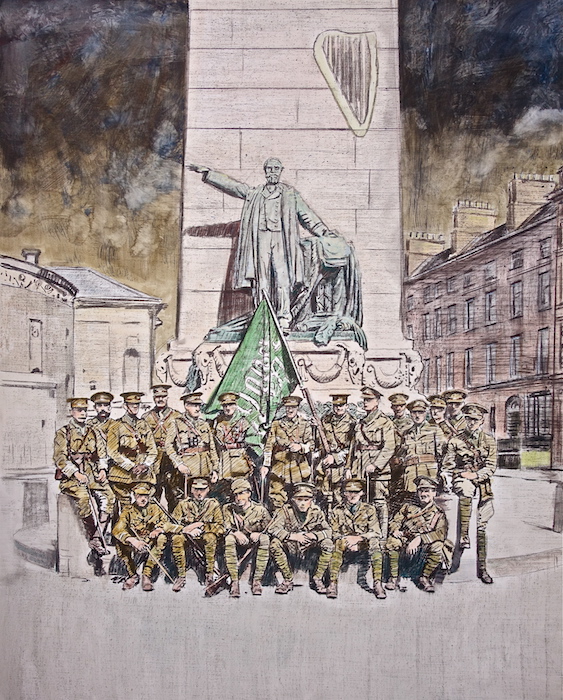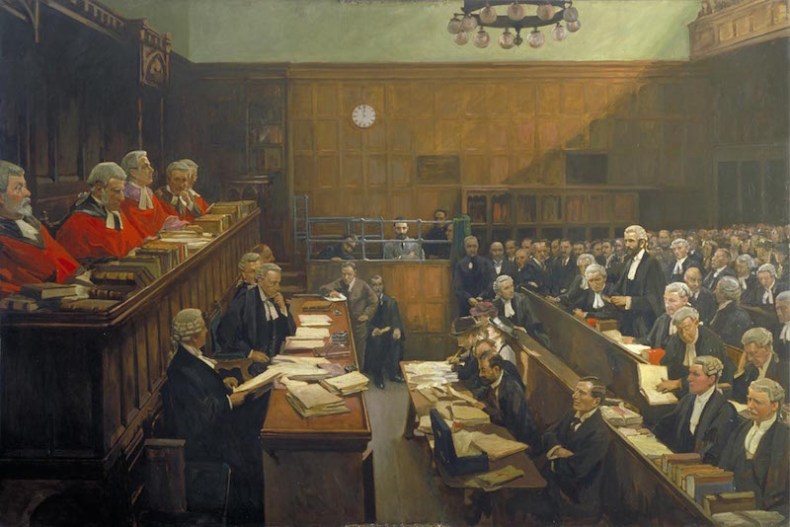Centenary commemorations have been coming thick and fast in Dublin over recent years, but this year is the big one: the Easter Rising of 1916. Inevitably, this has already provoked a torrent of articles, books and broadcasts, several of which have highlighted how the rebels’ literary and theatrical interests influenced the staging of the rebellion. But some of those involved in the Easter Rising were art school kids too. William Pearse, brother of the more famous Patrick, trained as a sculptor at Dublin’s Metropolitan School of Art under Oliver Sheppard; Countess Markievicz attended the Slade in London. The insurrection was, at least in part, an artists’ plot that enacted a powerful visual spectacle.
It is poignant, therefore, that the Rising was to have such catastrophic consequences for one of the city’s main artistic institutions. The Royal Hibernian Academy, with its annual exhibition on the walls, was burnt out in the fighting. Everything in the show was destroyed, as were the permanent collection and library. And it was not until 1985 that the Academy would again hold its annual exhibition in a gallery that was its own. An exhibit soon to open there, ‘27th of April Last’ (22 March–11 June), will consider the events of 1916 and the subsequent peripatetic history of the institution.

Study for War Trophies (2015), Mick O’Dea. Image courtesy of the artist and Kevin Kavanagh Gallery, Dublin
Earlier this year, the current president of the Academy, Mick O’Dea, had an exhibition called ‘The Foggy Dew’, which filled one of its galleries with four large canvases recreating scenes from the Rising – including the old Academy ablaze. Executed mostly in sombre brown, black, and grey tones, the paintings are at once ghostly and cartoon-like. Set alongside them were several large cardboard sculptures by O’Dea that evoke the power and fragility of monuments of various kinds. These were themselves offset by a dozen life-sized falling cardboard soldiers, dramatically suspended from the ceiling. Triumphalism of any kind was skewered by a show that reckoned with the human and material cost of the rebellion and its suppression, as well as the troubling continuing presence of the dead within Irish history.
The National Gallery came through the Rising unscathed. Its minute books reportedly contain just one reference to the event, when the governors and guardians conveyed to the Academy their sympathy over the destruction of its premises. But the gallery’s registrar, the novelist and poet James Stephens, soon afterwards published a classic account of the rebellion, The Insurrection in Dublin (1916). At work on the Easter Monday, Stephens evocatively reports walking out into the city at lunchtime and slowly realising that ‘the rumour of war and death’ was now ‘in the air’, as ‘continually and from every direction’ he heard rifles ‘crackling and rolling’.
A small display at the National Gallery (until 24 April) pays tribute to Stephen’s memoir, with portraits of the author and some of the individuals that the book mentions, as well as depictions of the city post-conflict. Hanging adjacent to offer some further sense of the Ireland of the day are roughly contemporaneous paintings by Paul Henry, Jack Yeats, William Orpen, and John Lavery. Later in the year, the gallery will mount ‘Creating History: Stories of Ireland in Art’ (8 October–17 January 2017). This will respond to what in official parlance has been labelled the ‘Decade of Centenaries’ more generally, by offering the long view on Irish inflections of the genre of history painting itself, bringing together 50 oils from the 17th century through to the 1930s.

The Appeal of Roger Casement. The Court of Criminal Appeal, 17 and 18 July 1916 (1916–31), John Lavery. Government Art Collection, London
In the meantime, a powerful instance of the artist acting as a witness to history will be offered across the city in Dublin City Gallery The Hugh Lane – an institution founded amid the maelstrom of art and politics that transformed the Ireland of 100 years ago. The centrepiece of its Easter Rising commemorations is the exhibition ‘High Treason: Roger Casement’ (10 March–2 October), featuring the rare public display of Lavery’s monumental painting High Treason: The Appeal of Roger Casement. The Court of Criminal Appeal, 17 and 18 July 1916. A highly successful society portrait painter, Lavery’s British establishment connections gained him access to the courtroom at the invitation of the presiding judge to witness the nationalist’s (unsucessful) appeal against his sentence of death for treason. But the painting also ambiguously marks a moment in which the artist, a Belfast-born Catholic, started to look on Irish nationalism in sympathy. The defence counsel is in full flow, but amid a sea of vivid faces listening on, Casement stares out of the dock, returning the viewer’s gaze – a haunting look to trouble the gallery’s living stream of visitors in this commemorative year.
From the March issue of Apollo: preview and subscribe here.

‘Many of those involved in the Easter Rising were art school kids’
Imperial City (2015), Mick O’Dea Image courtesy of the artist and Kevin Kavanagh Gallery, Dublin
Share
Centenary commemorations have been coming thick and fast in Dublin over recent years, but this year is the big one: the Easter Rising of 1916. Inevitably, this has already provoked a torrent of articles, books and broadcasts, several of which have highlighted how the rebels’ literary and theatrical interests influenced the staging of the rebellion. But some of those involved in the Easter Rising were art school kids too. William Pearse, brother of the more famous Patrick, trained as a sculptor at Dublin’s Metropolitan School of Art under Oliver Sheppard; Countess Markievicz attended the Slade in London. The insurrection was, at least in part, an artists’ plot that enacted a powerful visual spectacle.
It is poignant, therefore, that the Rising was to have such catastrophic consequences for one of the city’s main artistic institutions. The Royal Hibernian Academy, with its annual exhibition on the walls, was burnt out in the fighting. Everything in the show was destroyed, as were the permanent collection and library. And it was not until 1985 that the Academy would again hold its annual exhibition in a gallery that was its own. An exhibit soon to open there, ‘27th of April Last’ (22 March–11 June), will consider the events of 1916 and the subsequent peripatetic history of the institution.
Study for War Trophies (2015), Mick O’Dea. Image courtesy of the artist and Kevin Kavanagh Gallery, Dublin
Earlier this year, the current president of the Academy, Mick O’Dea, had an exhibition called ‘The Foggy Dew’, which filled one of its galleries with four large canvases recreating scenes from the Rising – including the old Academy ablaze. Executed mostly in sombre brown, black, and grey tones, the paintings are at once ghostly and cartoon-like. Set alongside them were several large cardboard sculptures by O’Dea that evoke the power and fragility of monuments of various kinds. These were themselves offset by a dozen life-sized falling cardboard soldiers, dramatically suspended from the ceiling. Triumphalism of any kind was skewered by a show that reckoned with the human and material cost of the rebellion and its suppression, as well as the troubling continuing presence of the dead within Irish history.
The National Gallery came through the Rising unscathed. Its minute books reportedly contain just one reference to the event, when the governors and guardians conveyed to the Academy their sympathy over the destruction of its premises. But the gallery’s registrar, the novelist and poet James Stephens, soon afterwards published a classic account of the rebellion, The Insurrection in Dublin (1916). At work on the Easter Monday, Stephens evocatively reports walking out into the city at lunchtime and slowly realising that ‘the rumour of war and death’ was now ‘in the air’, as ‘continually and from every direction’ he heard rifles ‘crackling and rolling’.
A small display at the National Gallery (until 24 April) pays tribute to Stephen’s memoir, with portraits of the author and some of the individuals that the book mentions, as well as depictions of the city post-conflict. Hanging adjacent to offer some further sense of the Ireland of the day are roughly contemporaneous paintings by Paul Henry, Jack Yeats, William Orpen, and John Lavery. Later in the year, the gallery will mount ‘Creating History: Stories of Ireland in Art’ (8 October–17 January 2017). This will respond to what in official parlance has been labelled the ‘Decade of Centenaries’ more generally, by offering the long view on Irish inflections of the genre of history painting itself, bringing together 50 oils from the 17th century through to the 1930s.
The Appeal of Roger Casement. The Court of Criminal Appeal, 17 and 18 July 1916 (1916–31), John Lavery. Government Art Collection, London
In the meantime, a powerful instance of the artist acting as a witness to history will be offered across the city in Dublin City Gallery The Hugh Lane – an institution founded amid the maelstrom of art and politics that transformed the Ireland of 100 years ago. The centrepiece of its Easter Rising commemorations is the exhibition ‘High Treason: Roger Casement’ (10 March–2 October), featuring the rare public display of Lavery’s monumental painting High Treason: The Appeal of Roger Casement. The Court of Criminal Appeal, 17 and 18 July 1916. A highly successful society portrait painter, Lavery’s British establishment connections gained him access to the courtroom at the invitation of the presiding judge to witness the nationalist’s (unsucessful) appeal against his sentence of death for treason. But the painting also ambiguously marks a moment in which the artist, a Belfast-born Catholic, started to look on Irish nationalism in sympathy. The defence counsel is in full flow, but amid a sea of vivid faces listening on, Casement stares out of the dock, returning the viewer’s gaze – a haunting look to trouble the gallery’s living stream of visitors in this commemorative year.
From the March issue of Apollo: preview and subscribe here.
Unlimited access from just $16 every 3 months
Subscribe to get unlimited and exclusive access to the top art stories, interviews and exhibition reviews.
Share
Recommended for you
Was there no Celtic Revival to vie with the Gothic?
‘The Celtic Revival in architecture depended upon ancient shrines, castles, and vernacular buildings’
Send them back: Sir Hugh Lane’s Impressionist icons belong in Ireland, not London
And the National Gallery knows it
Birthday Gifts: The National Gallery of Ireland
The NGI is 150 years old. Its holdings have been enriched by several benefactors. If only the state were as generous